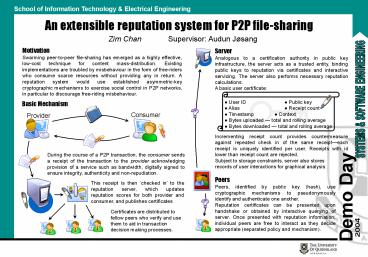An extensible reputation system for P2P filesharing PowerPoint PPT Presentation
1 / 1
Title: An extensible reputation system for P2P filesharing
1
An extensible reputation system for P2P
file-sharing
Zim Chan Supervisor Audun Jøsang
Motivation Swarming peer-to-peer file-sharing has
emerged as a highly effective, low-cost technique
for content mass-distribution. Existing
implementations are troubled by misbehaviour in
the form of free-riders who consume scarce
resources without providing any in return. A
reputation system would use established
asymmetric-key cryptographic mechanisms to
exercise social control in P2P networks, in
particular to discourage free-riding misbehaviour.
Server Analogous to a certification authority in
public key infrastructure, the server acts as a
trusted entity, binding public keys to reputation
via certificates and interactive servicing. The
server also performs necessary reputation
calculations. A basic user certificate
? User ID ? Public key ? Alias ? Receipt
count ? Timestamp ? Context ? Bytes uploaded
total and rolling average ? Bytes downloaded
total and rolling average
Basic Mechanism
Consumer
Provider
Incrementing receipt count provides
countermeasure against repeated check in of the
same receipteach receipt is uniquely identified
per user. Receipts with id lower than receipt
count are rejected. Subject to storage
constraints, server also stores records of user
interactions for graphical analysis.
During the course of a P2P transaction, the
consumer sends a receipt of the transaction to
the provider acknowledging provision of a service
such as bandwidth, digitally signed to ensure
integrity, authenticity and non-repudiation.
Peers Peers, identified by public key (hash), use
cryptographic mechanisms to pseudonymously
identify and authenticate one another. Reputation
certificates can be presented upon handshake or
obtained by interactive querying of server. Once
presented with reputation information, individual
peers are free to interact as they decide
appropriate (separated policy and mechanism).
This receipt is then checked in to the
reputation server, which updates reputation
scores for both provider and consumer, and
publishes certificates
Certificates are distributed to fellow peers who
verify and use them to aid in transaction
decision making processes.

